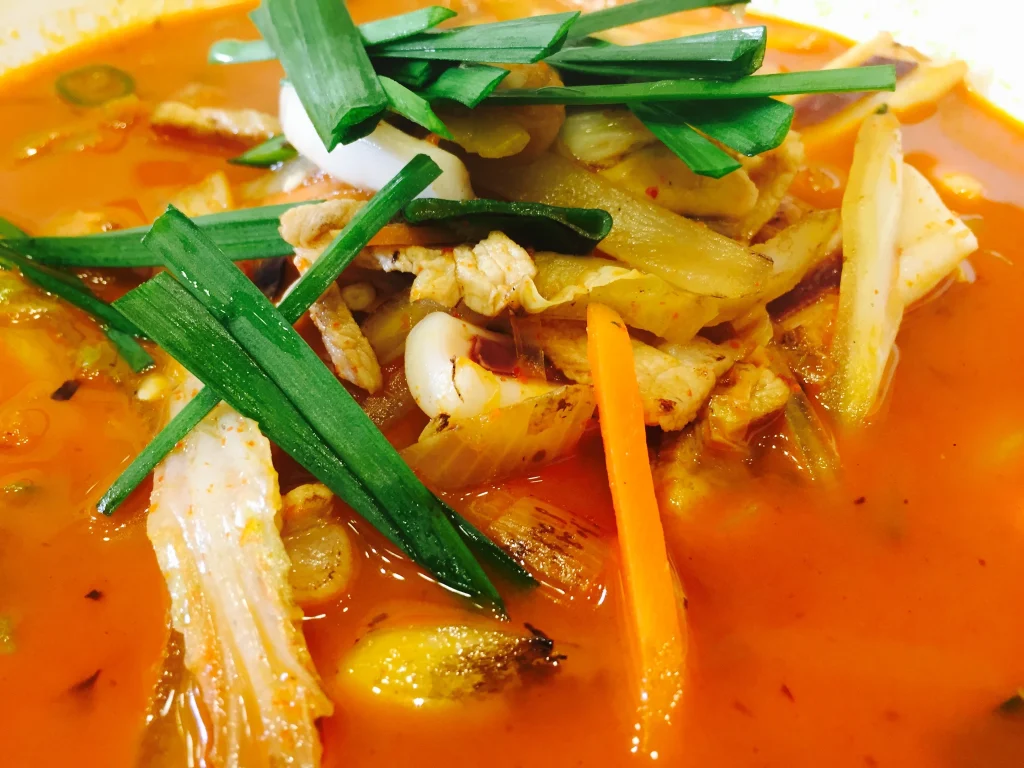The Best Fluffy Pancakes recipe you will fall in love with. Full of tips and tricks to help you make the best pancakes.
If you’ve ever craved the rich, aromatic, and spicy flavors of authentic Thai cuisine, nothing quite hits the spot like a perfectly crafted Thai red curry. This vibrant dish combines the creamy sweetness of coconut milk with bold red chili peppers, fragrant herbs, and a delicate balance of salty, sweet, and spicy notes. While Thai red curry might seem intimidating to make at home, it’s actually quite approachable once you know the essential ingredients and techniques.
In this blog, I’m going to share the secrets to making Thai red curry that’s bursting with flavor and comes out perfect every single time. From making your own red curry paste to choosing the best proteins and balancing flavors, you’ll learn everything you need to cook this iconic Thai dish like a pro — no matter your experience level. Let’s dive into the delicious world of Thai red curry and unlock the secrets behind its unforgettable taste!
Understanding Thai Red Curry: Ingredients and Flavors
Thai red curry is a beautiful harmony of flavors that showcases the complexity and depth of Thai cuisine. At its core, this dish balances creamy, spicy, sweet, and salty tastes, creating a vibrant and satisfying meal. To truly master Thai red curry, it’s important to understand what makes its flavor profile so unique and the key ingredients that bring it to life.

Understanding Thai Red Curry: Ingredients and Flavors
Thai red curry is a beautiful harmony of flavors that showcases the complexity and depth of Thai cuisine. At its core, this dish balances creamy, spicy, sweet, and salty tastes, creating a vibrant and satisfying meal. To truly master Thai red curry, it’s important to understand what makes its flavor profile so unique and the key ingredients that bring it to life.
How to Make Authentic Thai Red Curry Paste from Scratch
Making your own Thai red curry paste from scratch is one of the best ways to unlock the true depth and authenticity of this beloved dish. While store-bought curry pastes can be convenient, they often lack the freshness, complexity, and vibrant aroma that homemade paste delivers. Plus, making it yourself lets you adjust the heat and flavors exactly to your liking. Here’s how to do it the traditional way.
Traditional Ingredients in Red Curry Paste
Authentic Thai red curry paste is a blend of fresh and dried ingredients carefully ground together to create a fragrant, spicy base. The star of the paste is dried red chili peppers, which provide heat and the signature red color. Other essential ingredients include garlic, shallots, galangal (a root similar to ginger with a sharper, more citrusy flavor), lemongrass, and kaffir lime zest or leaves for that bright, citrus aroma. Shrimp paste adds a savory umami punch, balancing the spice with depth. Fresh coriander root or stems may also be included for an earthy undertone. Using these fresh components ensures your curry paste has vibrant flavor and aroma.
Step-by-Step Guide to Grinding and Blending Paste
Traditionally, Thai curry pastes were made by pounding the ingredients together with a mortar and pestle to release oils and combine flavors thoroughly. Here’s a simple process you can follow: soak dried red chilies in warm water until soft, then finely chop or blend all the fresh herbs and aromatics. Start by pounding the garlic, shallots, and chilies until they form a coarse paste, then gradually add galangal, lemongrass, kaffir lime zest, and shrimp paste. If you don’t have a mortar and pestle, a high-powered blender or food processor can work—just be careful not to over-blend or you’ll lose some texture. The goal is a smooth, fragrant paste that’s ready to infuse your curry with bold flavor.
Tips for Storing and Using Homemade Curry Paste
Once you’ve made your curry paste, storing it properly helps keep it fresh and flavorful for weeks. Transfer the paste to an airtight container and refrigerate for up to two weeks, or freeze in small portions (like ice cube trays) for up to 3 months. This way, you can thaw only what you need each time you cook. When using the paste, fry it gently in a bit of oil at the start of your recipe to release its rich aromas before adding coconut milk or other liquids. This simple step intensifies the flavor and ensures your Thai red curry is bursting with authentic taste every time.
Cooking the Perfect Thai Red Curry: Step-by-Step
Cooking Thai red curry is all about layering flavors and textures to achieve a rich, creamy, and perfectly balanced dish. Once you have your fresh red curry paste ready, the next step is learning the right techniques to bring everything together beautifully. Here’s a step-by-step guide to help you cook a restaurant-quality Thai red curry every time.
Choosing Your Protein: Chicken, Shrimp, Tofu, or Vegetables
Thai red curry is versatile and pairs wonderfully with a variety of proteins and vegetables. Chicken is a popular choice thanks to its mild flavor and quick cooking time. Shrimp adds a delightful sweetness and tender bite, while tofu is perfect for a vegetarian or vegan version, soaking up the curry sauce beautifully. For a vegetable-focused curry, try adding eggplant, bell peppers, bamboo shoots, or baby corn. Make sure to cut your proteins and veggies into even pieces for uniform cooking and to keep the dish balanced.
Balancing Flavors: Fish Sauce, Palm Sugar, and Coconut Milk
The magic of Thai red curry lies in balancing salty, sweet, spicy, and creamy elements. After frying your curry paste to release its aroma, add coconut milk slowly to create a rich, velvety base. Fish sauce provides the essential salty umami flavor that enhances the overall depth, but be careful not to add too much at once — taste as you go. Palm sugar (or brown sugar as a substitute) adds a subtle sweetness that tempers the heat and brings harmony to the curry. Adjust these ingredients gradually, tasting frequently, until you reach that perfect balance.
Cooking Techniques for a Rich, Creamy Curry Sauce
Start by gently frying the red curry paste in a little oil over medium heat to unlock its fragrance and flavors—this step is crucial. Once the paste is aromatic, pour in the coconut milk, stirring well to combine. Allow the curry to simmer gently; avoid boiling vigorously as this can cause the coconut milk to separate. Add your protein first since it generally requires more cooking time, followed by vegetables that cook quickly to keep their texture. Stir occasionally and let the curry reduce slightly, thickening into a luscious sauce that clings to every bite.
Serving Suggestions and Side Dishes for Thai Red Curry
A perfectly cooked Thai red curry deserves to be enjoyed with the right accompaniments that enhance its flavors and create a complete, satisfying meal. From the ideal rice pairing to refreshing sides and finishing garnishes, these serving suggestions will help elevate your Thai red curry experience.
Pairing with Jasmine Rice and Other Rice Varieties
The classic companion to Thai red curry is fragrant jasmine rice. Its slightly sticky texture and floral aroma perfectly complement the rich, creamy curry sauce and help balance the bold spices. For a healthier twist, you can also serve the curry with brown jasmine rice or fragrant basmati rice. Sticky rice (glutinous rice) is another traditional choice, especially in Northern and Northeastern Thailand, providing a chewy texture that’s perfect for soaking up the curry’s sauce.
Complementary Side Dishes: Thai Cucumber Salad, Spring Rolls
To balance the richness and spice of red curry, light and refreshing side dishes are ideal. A Thai cucumber salad, made with thinly sliced cucumbers, red onions, and a tangy lime and fish sauce dressing, offers a crisp, cooling contrast. Fresh spring rolls filled with herbs, shrimp, or tofu wrapped in rice paper bring fresh, herbal notes and a textural contrast that pairs beautifully with the curry. You can also consider serving som tam (green papaya salad) for a spicy, crunchy side that adds a different dimension of flavor.
Garnishes and Finishing Touches: Fresh Thai Basil, Lime Wedges
Adding fresh garnishes to your Thai red curry not only makes the dish look beautiful but also enhances its flavor layers. Thai basil leaves add a sweet, slightly peppery aroma that complements the curry’s spiciness. Kaffir lime leaves or thin strips of fresh lime zest brighten the dish with a citrusy kick. A squeeze of fresh lime juice right before serving can elevate the flavors even more. For those who like extra heat, sliced fresh Thai chili peppers or a sprinkle of chili flakes can be added as well.
Troubleshooting and Tips: How to Perfect Your Thai Red Curry Every Time
Even with the best ingredients and intentions, cooking Thai red curry can sometimes come with challenges. Whether it’s balancing flavors, adjusting spice levels, or dealing with texture issues, knowing how to troubleshoot common problems will help you create a flawless curry every time. Here are some practical tips to keep your dish tasting amazing.
How to Adjust Spice Levels and Sweetness
Thai red curry is known for its heat, but the spice level can always be tailored to your preference. If your curry turns out too spicy, add more coconut milk or a small amount of sugar to mellow the heat without diluting the flavor. For a milder curry, reduce the amount of red curry paste or remove the seeds from dried chilies before making your paste. On the other hand, if your curry is too mild, add finely chopped fresh Thai chilies or a bit more curry paste to boost the spice. When it comes to sweetness, palm sugar is the traditional choice, but you can substitute with brown sugar or honey, adjusting slowly until the curry hits the perfect balance.
Common Mistakes and How to Avoid Them
One common mistake is overheating the coconut milk, which can cause it to separate and create an oily texture. To avoid this, simmer your curry gently over medium or low heat instead of boiling vigorously. Another pitfall is adding fish sauce or salt too early or in excess — always add these salty elements gradually and taste as you go to avoid overpowering the dish. Using pre-made curry paste can be tempting, but ensure it’s high-quality or homemade for the best flavor. Also, undercooking vegetables can leave them tough, while overcooking makes them mushy; adding them towards the end helps maintain texture.
Storing Leftovers and Reheating Tips for Best Flavor
Thai red curry tastes even better the next day as the flavors continue to meld, but proper storage and reheating are key. Store leftovers in an airtight container in the refrigerator for up to 3 days or freeze for up to a month. When reheating, do so gently on the stovetop over low heat, adding a splash of coconut milk or water if the sauce has thickened too much. Avoid microwaving at high power, which can cause the sauce to separate. Stir frequently and heat until warmed through for the best texture and flavor.





